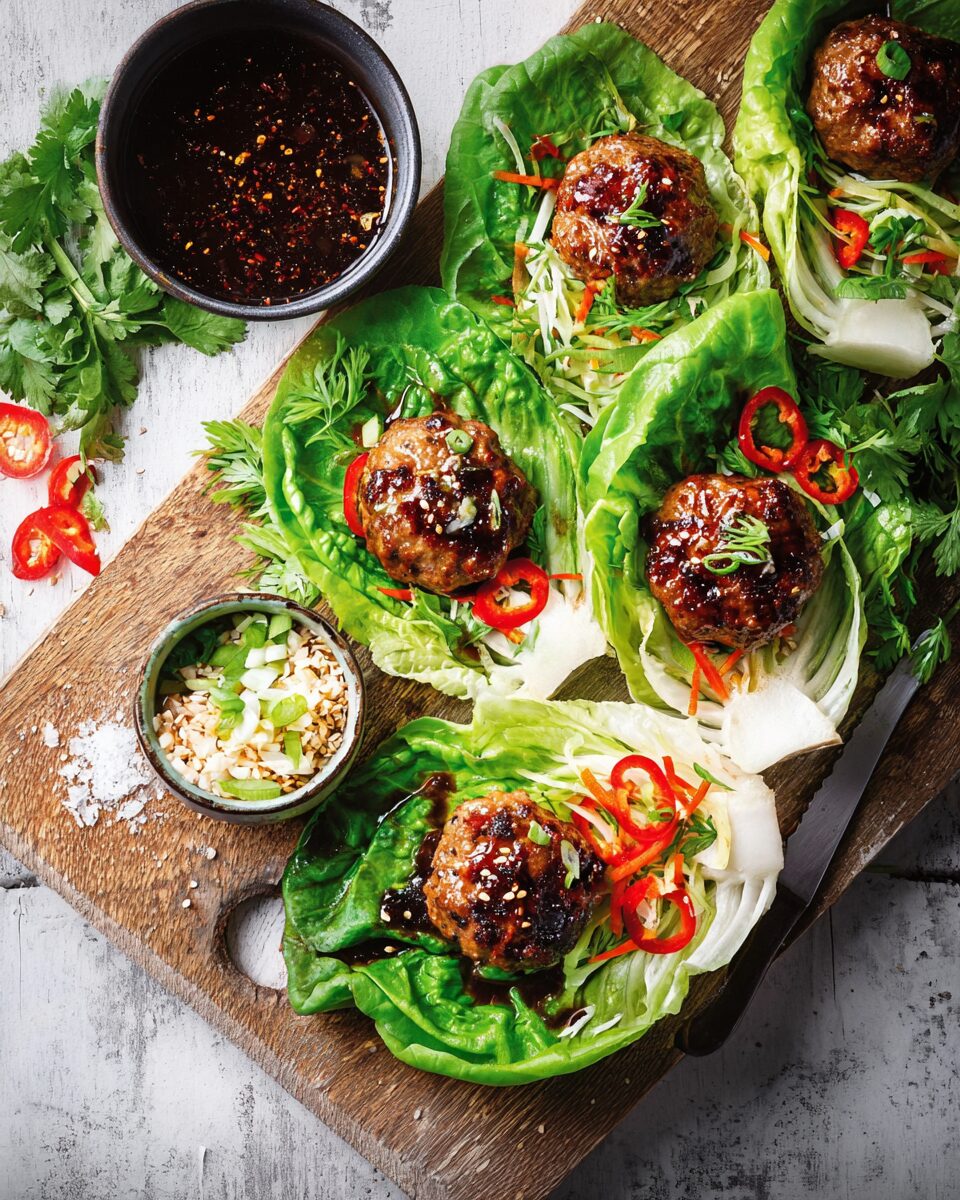These Sticky San Choy Bao Pork Rissoles are the perfect union of comfort and creativity. Inspired by the beloved Chinese san choy bao, this recipe transforms classic pork rissoles into handheld delights bursting with umami and aromatic ginger-garlic flair. The sticky char siu glaze adds that crave-worthy caramelized finish while the lettuce cups deliver a refreshing crunch.
Whether you’re cooking for guests or simply jazzing up your weeknight dinner, this dish brings color, texture, and bold flavor to the table with minimal fuss. Top it with crunchy veg, herbs, and a hint of chilli, and you’ll have a stunning platter that’s light yet deeply satisfying. Plus, they’re fun to assemble and even more fun to eat!
Full Recipe:
-
500g pork mince
-
2 garlic cloves, crushed
-
2 green onions, finely chopped
-
1 tablespoon ginger, finely grated
-
1 tablespoon soy sauce
-
1 tablespoon hoisin sauce
-
1 egg
-
1/2 cup panko breadcrumbs
-
1 tablespoon sesame oil
-
1/2 cup char siu sauce
-
1 tablespoon sweet chilli sauce
-
1 tablespoon lime juice
-
8 iceberg lettuce leaves
-
1 cup shredded carrot
-
1 cup bean sprouts
-
1/4 cup coriander leaves
-
1 long red chilli, finely sliced (optional)
Directions:
-
In a bowl, combine pork mince, garlic, green onions, ginger, soy sauce, hoisin sauce, egg, breadcrumbs, and a pinch of salt. Mix well and form into 8 rissoles.
-
Heat sesame oil in a non-stick frying pan over medium heat. Cook the rissoles for 4–5 minutes on each side or until golden and cooked through.
-
Meanwhile, combine char siu sauce, sweet chilli sauce, and lime juice in a small saucepan over low heat. Cook for 1–2 minutes until warm.
-
Pour half the sauce over the rissoles in the pan and toss to coat.
-
To serve, place each rissole in a lettuce cup. Top with shredded carrot, bean sprouts, coriander, and chilli if using. Drizzle remaining sauce on top.
-
Serve immediately and enjoy your San Choy Bao-style feast!
Prep Time: 15 minutes | Cooking Time: 20 minutes | Total Time: 35 minutes
Kcal: 280 kcal | Servings: 4 servings
History and Origin
The Sticky San Choy Bao Pork Rissoles recipe is a contemporary take on two culinary classics: the humble rissole and Chinese san choy bao.
Rissoles have deep roots in British and Australian culinary history. Traditionally, they were a way to use up leftover meat, mixed with breadcrumbs and herbs, then shaped into patties and fried. Over the decades, they’ve become a staple in Australian households—served with mash and veggies or tucked into a sandwich.
San choy bao, on the other hand, hails from Cantonese cuisine and literally translates to “lettuce bun.” It typically involves minced meat—often pork—stir-fried with aromatics and soy-based sauces, then spooned into lettuce cups for a refreshing, handheld appetizer. It’s popular both in Chinese households and in Western Chinese restaurants, especially during banquets or as a starter dish.
The genius of this modern recipe lies in its fusion of the two: juicy, seasoned pork patties with the sticky-sweet finish of a Chinese glaze, served in lettuce wraps with raw veggies for contrast. It embodies the global kitchen we live in today, where east meets west deliciously.
Variations and Adaptations
One of the best things about this recipe is how easily it adapts to personal preferences, dietary needs, and regional ingredients. For instance:
-
You can swap pork for ground chicken, turkey, or even firm tofu for a lighter, leaner version. Ground beef works too, though it gives the dish a different richness.
-
Don’t have char siu? A combination of hoisin, soy, honey, and five spice powder gives a similar flavor profile. You can even go Korean-style with a gochujang glaze for a spicy twist.
-
Grated zucchini, chopped water chestnuts, or mushrooms can be added to the pork mix for extra moisture and a nutritional boost.
-
While iceberg is classic for crunch, butter lettuce or baby cos (romaine) also work beautifully.
-
Going low-carb or keto? Ditch the breadcrumbs for almond meal or crushed pork rinds.
This is one of those recipes that encourages creativity. Whether you’re making it spicier, leaner, or entirely vegetarian, the base idea holds strong.
Nutritional Information
At first glance, Sticky San Choy Bao Pork Rissoles might seem indulgent because of the glaze, but it can be a balanced meal depending on how you serve it. Here’s a rough breakdown per serving (based on a 4-serving yield):
-
Calories: ~280 kcal
-
Protein: 20–25g
-
Fat: 12–15g (depending on the fat content of the pork)
-
Carbohydrates: 10–15g
-
Fiber: 2–3g
-
Sugar: 6–8g (mainly from the glaze)
Using lean pork mince and loading up on fresh vegetables makes this a high-protein, low-carb option suitable for people watching their macros. Plus, it’s naturally gluten-free if you use gluten-free soy and hoisin sauces.
What’s more, the lettuce wrap method replaces traditional rice or bread with a refreshing, fiber-rich base—great for those reducing starchy carbs.
Serving Suggestions and Pairings
These rissoles are incredibly versatile and lend themselves to several serving styles:
-
Serve three or four rissoles per person in lettuce cups with extra shredded veggies and a bowl of steamed jasmine or brown rice on the side.
-
Make smaller, bite-sized rissoles and offer them with mini lettuce leaves and dipping sauces like sriracha mayo or sesame-lime soy sauce.
-
Wrap two rissoles in lettuce, top with slaw and herbs, and serve with a side of miso soup or a cucumber salad.
For drinks, try pairing with light beers like pilsners or lagers, or aromatic white wines like Riesling. Sparkling water with lime and mint makes a great alcohol-free option. For dessert, opt for something light and citrusy like lime sorbet or coconut sago pudding.
Tips and Tricks for Success
-
Don’t overwork the mince. When mixing the rissole ingredients, stop as soon as everything comes together to keep the patties tender.
-
Wet your hands when forming rissoles to prevent sticking and get smooth, uniform shapes.
-
Use non-stick or well-oiled pans to avoid breaking the rissoles while turning.
-
Apply the sticky sauce during the last few minutes of cooking so it caramelizes without burning.
-
Pre-chill the lettuce leaves in ice water for a few minutes before serving—they’ll be extra crisp and refreshing.
These small steps go a long way in elevating the final dish from good to great.
Potential Health Benefits
Many of the ingredients in this dish offer more than just flavor:
-
Ginger has anti-inflammatory properties and aids digestion.
-
Garlic supports heart health and boosts immunity.
-
Pork is an excellent source of B vitamins, iron, and high-quality protein.
-
Lettuce, carrots, and bean sprouts provide fiber, vitamin C, and hydration.
-
Coriander may support detoxification and has antimicrobial effects.
Combined, they create a nutrient-dense meal that doesn’t sacrifice taste for health.
Conclusion
Sticky San Choy Bao Pork Rissoles are a celebration of culinary creativity—where East meets West in a fresh, flavorful, and family-friendly way. They’re quick enough for weeknight meals, impressive enough for guests, and healthy enough to fit into a balanced lifestyle.
Whether you’re introducing your family to new flavors or looking for a lightened-up way to enjoy classic comfort food, this recipe checks all the boxes. With its mix of textures, bold sauces, and fun-to-eat format, it’s the kind of dish that becomes a regular request.
Give it a try, play around with your own twist, and don’t forget to savor every bite!





